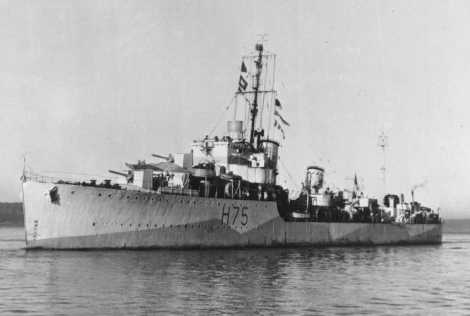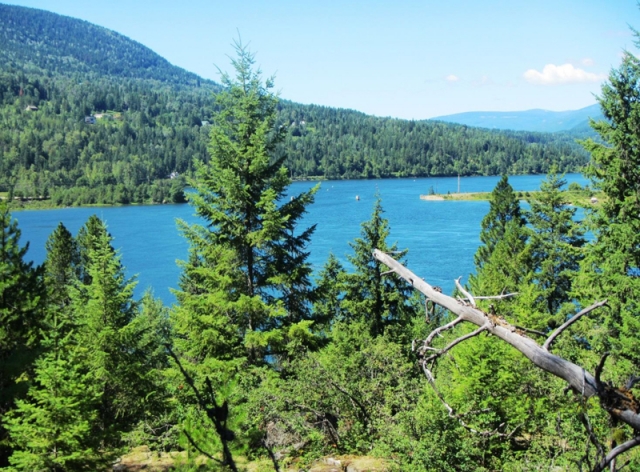Remembering: Kootenays boast proud naval heritage
Kootenay Country boasts a proud history of naval namesakes; there were two HMCS Kootenay naval vessels, and both of them have histories well worth the telling as Remembrance Day approaches.
The first HMCS Kootenay, a destroyer, was built for the Royal Navy and was commissioned as the HMS Decoy in 1933. During World War II, she saw most of her action in the Mediterranean between Greece and north Africa, with a stint in the North Atlantic just before her transfer into Canadian hands . On April 12, 1943 she was transferred and recommissioned by the Royal Canadian Navy as an escort destroyer. She had a crew of 145, and she saw most of her action during World War II in the North Atlantic, in the English Channel, and in the Bay of Biscay.
She is known for four particular events. On May 22, 1943, she rescued 19 Norwegian sailors whose tanker had been destroyed by a German submarine in the North Atlantic. On July 7, 1944, the Kootenay was part of a trio of ships, including the HMCS Ottawa and a Royal Navy corvette called the HMS Statice, that sunk a German submarine in the English Channel just off the shores of Brighton.
Later on that summer, on Aug. 18, the Kootenay once again teamed up with the Ottawa, and along with the HMCS Chaudière, depth-charged a German U-boat in the Bay of Biscay, near a place called La Rochelle. Two days later, this same trio of Canadian ships destroyed a third German U-boat again in the Bay of Biscay, this time very near Brest. She ended her career on Oct.26, 1945, when she was decommissioned and, in January 1946, she was broken up. This ship, both in its capacities as HMS Decoy and HMCS Kootenay, enjoyed a long and successful career and came through the war in one piece.
The same cannot be said for the second incarnation of the HMCS Kootenay. Built in Vancouver, launched in 1954, and commissioned by the Royal Canadian Navy March 7, 1959, this Restigouche-class destroyer didn’t see any military action during its time in the navy, however it was the scene of two serious accidents, including one that saw nine sailors die and many others injured.
This happened Oct. 23, 1969, while the Kootenay was on a routine exercise with a large group of Canadian naval vessels about 200 miles west of Plymouth, England. The Kootenay and her sister ship, the HMCS Saguenay, were ordered to break away from the rest of the ships and “carry out full power trials.” Ten minutes after achieving full throttle, a gearbox in the engine room exploded, spewing oil everywhere, and engulfing the engine room in flames. Six of the ten men manning the engineering room were killed immediately. Four others managed to escape via the one available hatch left, but one of them died at the top. The three remaining sailors suffered severe burns. Outside of the engineering room, one crewman died of smoke inhalation in the cafeteria, and yet another sailor, who was trapped in the galley, made it out of the ship alive, but died aboard the HMCS Bonaventure from his injuries a few days later. 53 other personnel were injured.
But this disaster at sea – which remains Canada’s worst naval peacetime accident – would claim one more life, albeit in a more indirect manner.
This tragedy has its fair share of heroes. One that stands out in this story is Sub Lieutenant Clark Reiffenstein, the ship’s 24-year-old navigator. In attempt to find and close a key emergency steam shut-off valve that would have stopped the still-charging engines, he put on scuba diving gear and went down the main hatch between the engineering room and the main part of the ship, a hatch called Burma Road, despite thick smoke and almost no visibility.
He was unable to find the valve, but he did find one of his crew mates, whom he brought to safety. Unfortunately, according one source, Reiffenstein’s guilt at not being able to find the emergency valve he sought took too much of a toll: suffering from what we now call Post Traumatic Stress Disorder, the lieutenant committed suicide a few months after the incident.
The second accident involving the Kootenay was a collision with a merchant ship in 1989, and the ship’s damaged bow was replaced with a bow from another ship of the same class, the HMCS Chaudiere, but this was not the same Chaudière that helped the previous Kootenay sink German U-boats during WWII (like the Koontenay, the Chaudière had two incarnations).
The second HMCS Kootenay definitely went through the ringer even though it only saw peacetime action. She was refitted twice between 1972 and 1983, and was eventually taken out of active service in November 1995. After that, she was taken to what would eventually be her final resting spot, in some nice warm waters far south of Canada: in 2001, she was sunk as an artificial reef off the shores of Acapulco.
I highly recommend readers visit the sites linked below, especially the Hazegray page because it contains a lot of DND photos of the damage done by the fire on the Kootenay in 1969.
Sources:
1. “An Incident on the High Seas” by Gord Forbes, published in “Soundings” (a publication by The Naval Officers Association of Canada), November 2007. http://www.noac.ottawa.on.ca/fallsoundings07.pdf
2. Stokers.ca: The Canadian Navy Stoker’s site. Article here: http://www.stokers.ca/hmcskootenay23october1969.htm
3. Armchair General.net.
4. www.hazegray.com. A site about naval history & photography. Article here: http://www.hazegray.org/navhist/canada/postwar/restigou/kootenay-explosion/
5. www.uboat.net. The photo of the HMCS Rossland was taken from this page: http://www.uboat.net/allies/warships/ship/2737.html
6. http://hmcskootenay.tripod.com/after_the_disaster.html
7. Wikipedia



























Comments